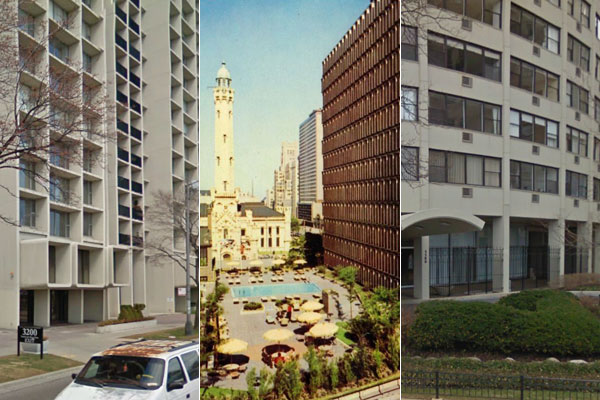
Update: Title corrected from "Macsai & Hausner." Also found this spectacular modernist house by Robert Hausner in Evanston.
Robert Powers, who runs the excellent chronicle of Chicago's midcentury architecture A Chicago Sojourn, has a nice tour of the Purple Hotel in Lincolnwood. It's unmissable if you've ever driven down Touhy, and even as it's fallen into total decrepitude—from Perry Como, to mob hits, to drug-fueled corruption, to sex clubs, to abandonment—it's remained a cult favorite of architecture nerds. Lee Bey had a good appreciation of it, beyond its now-kitschy glazed purple brick, back in March. (Unfortunately it's not that much to look at inside, even if you can set aside the rot.)
The Purple Hotel, originally known as the Hyatt Lincolnwood, was designed by Hausner & Macsai, whose real architectural legacy stretches up Lake Shore Drive. The fact that that narrow corridor is reminiscent of Miami Beach is due in part to the firm, having built 21 E. Chestnut, 1400 N. State Parkway, 1100 N. Lake Shore, 1240 N. Lake Shore, the Harbor House at 3200 N. Lake Shore, and the familiar, curved 1150 N. Lake Shore, the firm's breakthrough building, which won an AIA award after it was built in 1958. the firm also did a lot of work on the University of Chicago campus, translating their concrete to a more severe architectural atmosphere with buildings for the Woodlawn Social Services Center, the National Opinion Research Center, and the High Energy Physics Building.
Of all those, it's Harbor House that John Macsai is most proud of, as he mentions several times in his UIC oral history:
I mean, Harbor House had enough innovation that most normal clients would not agree to it. But Marv was a courageous young developer, who thought that… And really, he pandered his courage into millions and millions of dollars. He’s a very successful, now retired, multi-millionaire former developer.
[snip]
First of all, it’s three elevator towers, there are no corridors. The corridors are as long as you saw here in this building. So every apartment has minimum corridor. Every apartment looks at the lake. There are no apartments which just only face west. About a third of the apartments have split bedrooms, which was the first.
[snip]
And we dropped the living room down three steps, which was another innovation. So you walk in and you have this wonderful high ceiling and sunken living room. But in order to maintain the symmetry, I had to put the dining area inside. And my client said—he understood why I’m doing it, and he says, "Okay, let’s see. I think it might appeal to the market." And it had tremendous appeal.
[snip]
Well, this was the other one that the columns and the slabs are all pulled out, outward instead of pushed inward. That had two advantages. One, it doesn’t jut into the room. It moves outward, so it creates cleaner interior spaces, and a more powerful, brutal, strong exterior on the outside.
The late Sun-Times architecture critic Bill Newman, according to Macsai, considered it in the same league as Ludwig Mies van der Rohe's apartment buildings; you can see from the external view what Macsai means by the external columns and slabs saving interior space and making the exterior distinctive.
You can see the ideas that would become Harbor House in Hausner & Macsai's Water Tower Inn, another Hyatt that's since been replaced by Luicen LaGrange's enormous Park Tower. It's a fantastically odd building, looking like Mies van der Rohe on the bottom and the old, (in)famous Sun-Times building; here's a view from alongside it, and what it looked like from the ground. And you can see from the pictures how the actual Water Tower wasn't lost in the towering Near North Side like it is now, something Macsai lamented:
The one place where I think the building uniquely respected that location, which the current building really does not, is that it was kept low—though we could have gone higher—not to dwarf the Water Tower. But what happened since, you know, to Michigan Avenue, Michigan Avenue lost that boulevard feeling and it became a canyon among these one-uglier-than-the-other high-rises. You know, the Hyatt is dwarfing it. It’s just too big.
Somewhere between the Water Tower Inn and the Purple Hotel was Hausner & Macsai's design for the Bel Air East in St. Louis, which like their Lake Shore buildings, has a touch of the Miami coast to it. It's since been turned in to a horrific Hampton Inn.
I think the first building I saw by Macsai was done after his Hausner & Macsai years—the Evanston Place. When I was 16, I did a summer program at Northwestern, and passed by it regularly. It's one of those buildings that's leaning towards generic, but there's a touch of craft in it; maybe it was the layout of the windows, or the distinctive, very-'90s archways, or the way the line of the porch railings continues into green pinstripes of brick. I think it was the brick, actually, a bit of glazed brick faintly echoing the Purple Hotel of Macsai's past.



